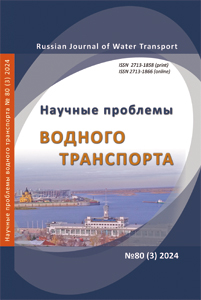A mathematical model of a liquid-loading vessel at the initial stages of design
Abstract
To substantiate the main unknowns at the initial stages of design and, above all, during the re-search design, it is necessary to develop a mathematical model as sensitive as possible to changes in variable parameters, which can be any elements of the vessel or its subsystems. The need to ensure seaworthiness, such as buoyancy, stability, unsinkability, strength, seaworthiness and capacity requires the inclusion of these modules in modeling either in the form of calculation functions, such as determining precipitation from the equation of mass and buoyancy, or in the form of restrictions requiring, if not fulfilled, recalculation of the former. The paper describes a similar mathematical model in relation to an oil tanker of mixed (river-sea) navigation of the M-SP class of the Russian Classification Society. Its feature is the use of computer-aided design of the hull shape and the inclusion in the mathematical model of the actual calculation of the elements of buoyancy, initial stability and capacity, rather than using statistical dependencies for them, which significantly increases the adequacy of the final result.
References
Гайкович А.И. Теория проектирования водоизмещающих кораблей и судов. В 2 т. Т1. Описание системы «Корабль». Санкт-Петербург: НИЦ МОРИНТЕХ, 2014. 819 с.
Кочнев, Ю. А. Математическая модель расчета массы танкера смешанного (река-море) плавания / Ю. А. Кочнев // Вестник Астраханского государственного техни-ческого университета. Серия: Морская техника и технология. – 2010. – № 1. – С. 7-12.
Россисйкое классификационное общество. Правила по предотвращению загрязне-ния с судов, эксплуатирующихся в морских районах и на внутренних водных путях российской федерации. URL: https://rfclass.ru/assets/Uploads/ppzs_ms.pdf?t=1710953576(Дата обращения: 20.03.2024).
Роннов, Е. П. Методика расчёта массы металлического корпуса танкера смешанно-го (река-море) плавания / Е. П. Роннов, Ю. А. Кочнев // Научные проблемы транс-порта Сибири и Дальнего Востока. – 2010. – № 1. – С. 114-118.
Басин, А.М. Ходкость и управляемость судов. Учебное пособие для ВУЗов водно-го транспорта / А.М. Басин. – М.: Транспорт, 1977. – 456с.
Фомкинский Л.И. Методика тяговых расчётов при обосновании судов речного флота//Труды ЦНИИЭВТа. –1972. –вып. 86. – с.1–184.
Платов А.Ю., Васильева О.Ю. Анализ применимости методов расчета коэффици-ента остаточного сопротивления для судов внутреннего плавания при эксплуата-ционно-экономическом обосновании новых судов // Вестник Волжской государ-ственной академии водного транспорта. Выпуск 60. – Н. Новгород: Изд-во ФГБОУ ВО «ВГУВТ», 2019 – с. 193-202.
Holtrop J, Mennen G.G.J. A statistical power prediction method / International ship-building progress, vol. 25, October 1978.
Кочнев, Ю. А. Прогнозирование сопротивления движению грузовых комбиниро-ванных судов в задаче их оптимизации / Ю. А. Кочнев, И. А. Гуляев // Великие ре-ки - 2020: Труды 22-го международного научно-промышленного форума, Нижний Новгород, 27–29 мая 2020 года. – Нижний Новгород: Волжский государственный университет водного транспорта, 2020. – С. 27.
Егоров, А. Г. Определение весовой нагрузки судов смешанного "река-море" плавания нового поколения в начальной стадии проектирования / А. Г. Егоров // Морской вестник. – 2013. – № 4(48). – С. 019-022.
Гуляев, И. А., Кочнев, Ю. А., Роннов, Е. П. Математическая модель расчета массы металлического корпуса комбинированного судна/ И. А. Гуляев, Ю. А. Коч-нев, Е. П. Роннов. // Научные проблемы водного транспорта. – 2020. – №63. – С. 48-54. – DOI 10.37890/jwt.vi63.75.
Давыдова, С. В. Анализ расчетов при создании теоретического чертежа бук-сира интерполяционным методом / С. В. Давыдова, И. В. Андриянов // Научные проблемы водного транспорта. – 2021. – № 67. – С. 24-32. – DOI 10.37890/jwt.vi67.191.
Платов А.Ю., Платов Ю.И. Необходимые условия адекватности экономико-математических моделей на речном транспорте // Научные проблемы водного транспорта. 2020. № 64. С. 171-179. DOI 10.37890/jwt.vi64.108.
Copyright (c) 2024 Russian Journal of Water Transport

This work is licensed under a Creative Commons Attribution 4.0 International License.













